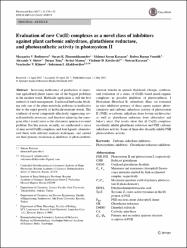| dc.contributor.author | Rodionova, Margarita V. | |
| dc.contributor.author | Zharmukhamedov, Sergei K. | |
| dc.contributor.author | Karacan, Mehmet Sayim | |
| dc.contributor.author | Venedik, Kubra Begum | |
| dc.contributor.author | Shitov, Alexandr V. | |
| dc.contributor.author | Tunc, Turgay | |
| dc.contributor.author | Mamas, Serhat | |
| dc.date.accessioned | 2019-11-24T20:38:19Z | |
| dc.date.available | 2019-11-24T20:38:19Z | |
| dc.date.issued | 2017 | |
| dc.identifier.issn | 0166-8595 | |
| dc.identifier.issn | 1573-5079 | |
| dc.identifier.uri | https://dx.doi.org/10.1007/s11120-017-0392-9 | |
| dc.identifier.uri | https://hdl.handle.net/20.500.12513/2505 | |
| dc.description | International Conference on Photosynthesis Research for Sustainability -- JUN 19-25, 2016 -- Pushchino, RUSSIA | en_US |
| dc.description | WOS: 000405086400013 | en_US |
| dc.description | PubMed ID: 28497193 | en_US |
| dc.description.abstract | Increasing inefficiency of production of important agricultural plants raises one of the biggest problems in the modern world. Herbicide application is still the best method of weed management. Traditional herbicides blocking only one of the plant metabolic pathways is ineffective due to the rapid growth of herbicide-resistant weeds. The synthesis of novel compounds effectively suppressing several metabolic processes, and therefore achieving the synergism effect would serve as the alternative approach to weed problem. For this reason, recently, we synthesized a series of nine novel Cu(II) complexes and four ligands, characterized them with different analyses techniques, and carried out their primary evaluation as inhibitors of photosynthetic electron transfer in spinach thylakoids (design, synthesis, and evaluation of a series of Cu(II) based metal-organic complexes as possible inhibitors of photosynthesis, J Photochem Photobiol B, submitted). Here, we evaluated in vitro inhibitory potency of these agents against: photochemistry and carbonic anhydrase activity of photosystem II (PSII); alpha-carbonic anhydrase from bovine erythrocytes; as well as glutathione reductase from chloroplast and baker's yeast. Our results show that all Cu(II) complexes excellently inhibit glutathione reductase and PSII carbonic anhydrase activity. Some of them also decently inhibit PSII photosynthetic activity. | en_US |
| dc.description.sponsorship | Int Soc Photosynthesis Res, Int Assoc Hydrogen Energy | en_US |
| dc.description.sponsorship | Scientific and Technological Research Council of Turkey (TUBITAK)Turkiye Bilimsel ve Teknolojik Arastirma Kurumu (TUBITAK) [212T089]; Russian Foundation for Basic ResearchRussian Foundation for Basic Research (RFBR) [16-34-50257, 17-04-01011, 17-54-560012, 17-0401289]; Molecular and Cell Biology Programs from Russian Academy of Sciences | en_US |
| dc.description.sponsorship | This study has been supported by the Scientific and Technological Research Council of Turkey (TUBITAK-Project No. 212T089), by the Grants from Russian Foundation for Basic Research (Nos. 16-34-50257, 17-04-01011, 17-54-560012, 17-0401289), and by Molecular and Cell Biology Programs from Russian Academy of Sciences. | en_US |
| dc.language.iso | eng | en_US |
| dc.publisher | SPRINGER | en_US |
| dc.relation.isversionof | 10.1007/s11120-017-0392-9 | en_US |
| dc.rights | info:eu-repo/semantics/closedAccess | en_US |
| dc.subject | Carbonic anhydrase inhibitors | en_US |
| dc.subject | Photosynthetic inhibitors | en_US |
| dc.subject | Glutathione reductase inhibitors | en_US |
| dc.title | Evaluation of new Cu(II) complexes as a novel class of inhibitors against plant carbonic anhydrase, glutathione reductase, and photosynthetic activity in photosystem II | en_US |
| dc.type | article | en_US |
| dc.relation.journal | PHOTOSYNTHESIS RESEARCH | en_US |
| dc.contributor.department | Kırşehir Ahi Evran Üniversitesi, Fen-Edebiyat Fakültesi, Kimya Bölümü | en_US |
| dc.identifier.volume | 133 | en_US |
| dc.identifier.issue | 1.Mar | en_US |
| dc.identifier.startpage | 139 | en_US |
| dc.identifier.endpage | 153 | en_US |
| dc.relation.publicationcategory | Makale - Uluslararası Hakemli Dergi - Kurum Öğretim Elemanı | en_US |


















